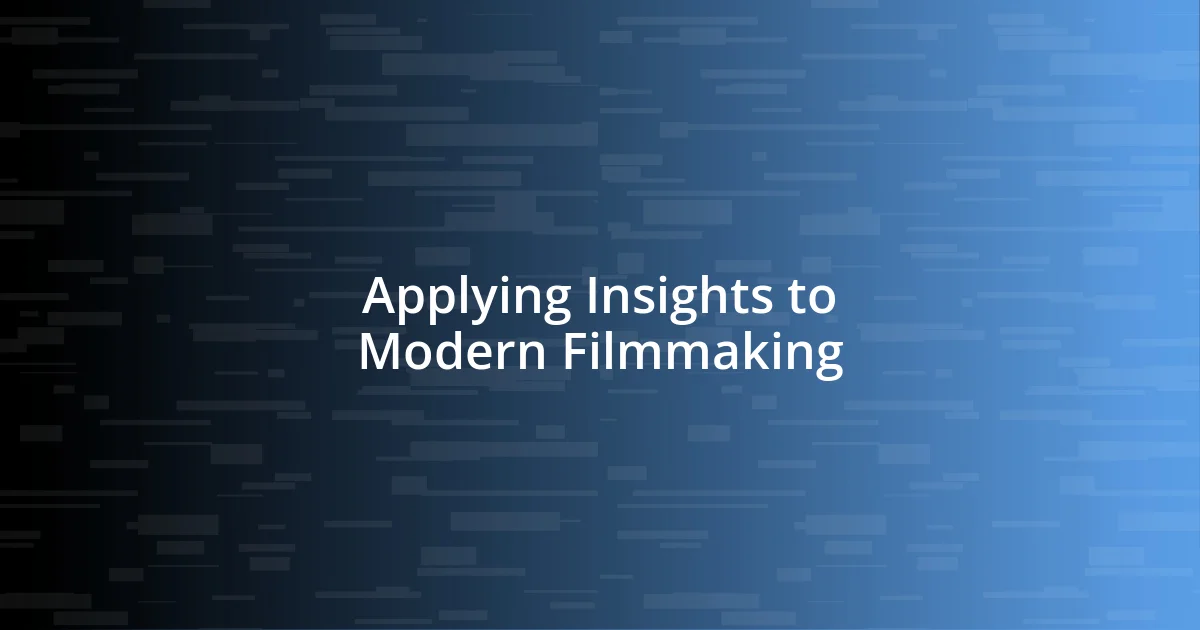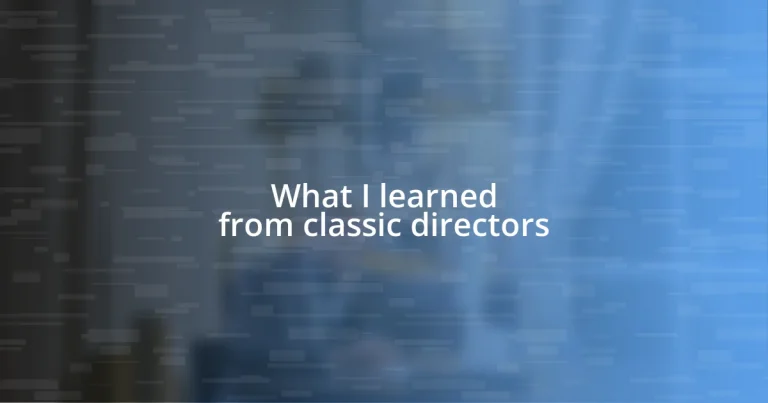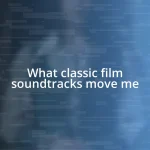Key takeaways:
- Classic directors like Alfred Hitchcock and Akira Kurosawa transformed storytelling through suspenseful narratives and complex themes, influencing modern filmmakers.
- Key techniques, such as innovative editing and visual composition, play a crucial role in creating emotional resonance and depth in storytelling.
- Lessons from classic directors emphasize the importance of character development, emotional depth, and breaking conventional storytelling rules in modern filmmaking.

Influence of Classic Directors
Classic directors have an indelible mark on the landscape of filmmaking, shaping how we perceive stories on the screen. I often think about how Alfred Hitchcock’s mastery of suspense not only influenced a generation of filmmakers but also transformed the viewer’s experience. When I first watched “Psycho,” I felt a palpable tension that lingered long after the credits rolled; it was a testament to how a director can manipulate emotions through cinematic techniques.
Many iconic filmmakers, like Akira Kurosawa, pushed the boundaries of storytelling, merging art with deeper philosophical themes. I remember watching “Seven Samurai” for the first time and being struck by the profound moral questions it posed. It made me wonder, how many films today challenge us in that same way? The ability of classic directors to intertwine complex narratives with stunning visuals makes their work timeless and relevant even decades later.
As I dive into the films of Jean-Luc Godard, I find that his innovative use of editing and narrative structure has profoundly influenced modern cinema, prompting filmmakers to break conventional norms. Reflecting on my experience while watching “Breathless,” I found myself captivated by its raw energy, illustrating how directors not only tell stories but also redefine the rules of engagement with their audience. Isn’t it fascinating how these classic approaches continually inspire new generations of directors to create their unique visions?

Key Techniques in Filmmaking
Classic directors utilize a variety of techniques that have fundamentally shaped the art of filmmaking. For instance, the use of light and shadow in film noir creates a distinct atmosphere that evokes emotions and heightens tension. I remember watching “Double Indemnity” and how the interplay of light brought the characters’ inner turmoil to life—it was striking.
Another significant technique is the innovative narrative structure that some classic directors employed. Take Orson Welles with “Citizen Kane,” for example. The non-linear storytelling and multiple perspectives had me rethinking the traditional storytelling approach. I found myself piecing together the protagonist’s life like a puzzle, which deepened my appreciation for narrative complexity.
Classic directors also mastered the art of character development. When I saw “The Searchers” by John Ford, I was drawn into the protagonist’s internal conflict, which was as riveting as the action on screen. The way Ford crafted characters with depth left a lasting impression on me, enhancing my understanding that films can be powerful vehicles for exploring human emotions.
| Director | Key Technique |
|---|---|
| Alfred Hitchcock | Mastery of Suspense |
| Akira Kurosawa | Complex Narratives |
| Jean-Luc Godard | Innovative Editing |
| Orson Welles | Non-linear Storytelling |
| John Ford | Character Depth |

Understanding Character Development
Understanding character development is crucial in appreciating classic films. I’ve often marveled at how directors breathe life into their characters, allowing us to connect with them deeply. In “Casablanca,” for example, I felt Rick Blaine’s heartache and complexity resonate with my own experiences of lost love. It’s fascinating how classic directors create fully-realized characters, each fraught with their own struggles, desires, and conflicts, making their arcs compelling.
- Use of Flaws: Classic directors often highlight character flaws, making them relatable. Watching characters grapple with their imperfections reminds us that nobody is perfect.
- Transformation: The journey of transformation is a powerful theme. I once found myself captivated by Scarlett O’Hara’s evolution in “Gone with the Wind,” reflecting my own growth during challenging times.
- Relationships: Explore the characters’ relationships. In “The Godfather,” the dynamics within the Corleone family shaped their identity and choices, impacting my perception of loyalty and power.
These elements of character development not only enhance the narrative but also evoke a multitude of emotions, leaving us with lasting impressions long after the film ends.

Examining Cinematic Storytelling
Examining cinematic storytelling reveals a fascinating tapestry of techniques that classic directors weave into their films. I recall sitting in a theater, transfixed during Hitchcock’s “Psycho,” as the tension built. The way he manipulated the audience’s expectations kept me on the edge of my seat, showing that every frame can tell a story beyond just dialogue. Isn’t it remarkable how a single scene can evoke such a visceral reaction?
When I reflect on Kurosawa’s “Rashomon,” I’m reminded of how the film uses multiple perspectives to reshape our understanding of truth. I found myself questioning my own biases as I watched characters narrate the same event with starkly different interpretations. This technique not only deepened my engagement but also encouraged a more nuanced view of storytelling—how personal experience can craft our realities in film and life.
It’s not just about how a story unfolds; it’s about the emotions it evokes and the connections it fosters. One scene from “The Seventh Seal” still haunts me: the chess game between Death and the knight symbolizes our struggle against the inevitable. I couldn’t help but ponder my own mortality and choices. Haven’t you ever watched a film and felt like it was reflecting your own fears and desires? These moments in cinema showcase the power directors hold over us, transforming mere entertainment into profound explorations of the human condition.

Impact of Visual Composition
The visual composition of classic films plays a pivotal role in how stories are experienced. I remember watching “2001: A Space Odyssey” and being struck by the sheer beauty of its visuals. Each shot is a meticulously arranged work of art, and I found myself absorbed in the imagery—like the mesmerizing star field that evoked a sense of wonder about the universe. Don’t you think that sometimes a single frame can impact our emotions even more than the dialogue itself?
When I think of visual composition, Alberto Giovanni’s “La Dolce Vita” comes to mind, particularly the iconic scene with the Trevi Fountain. The way that scene was framed captured not only the beauty of the location but also the longing of the characters. This taught me how effective composition can enhance narrative depth. It’s incredible how the placement and movement of characters within a frame can amplify their feelings, don’t you agree?
Moreover, the use of color, light, and shadow in films also creates an emotional resonance that’s hard to ignore. In “The Wizard of Oz,” the transition from sepia-toned Kansas to the vibrant Technicolor of Oz represents a sensory awakening that felt almost magical to me. It made me realize how crucial visual elements are in establishing mood and tone. Have you ever watched a film and felt transported simply by its colors and composition, as if you could step right into that world? This prompts me to appreciate the craftsmanship of directors who deftly utilize these visual tools to elevate their storytelling.

Lessons on Directing Style
I’ve found that classic directors often showcase unique styles that resonate deeply with audiences. For instance, watching Billy Wilder’s “Sunset Boulevard” for the first time left a lasting impression on me. The way he uses the darkly humorous narrative to critique Hollywood really made me reflect on the duality of fame and the cost of dreams. Doesn’t it make you think about the stories we tell ourselves in pursuit of success?
Another lesson that stands out is how Martin Scorsese’s use of music shapes the viewer’s experience. When I first heard the iconic “Gimme Shelter” in “Goodfellas,” it elevated a gripping scene to a whole new level. The intensity of the music enveloped me, intensifying my emotional connection to the characters. Isn’t it fascinating how a well-placed song can become a character in its own right, guiding our feelings and responses?
Then there’s the fluidity of style I’ve observed in directors like Jean-Luc Godard. His experimental approach in “Breathless” reminded me that altering narrative structure can invite viewers into a more active role. I still remember the punch of his jump cuts; they broke conventions and left my mind racing. How liberating is it to realize that storytelling can be shaped by breaking the ‘rules’?

Applying Insights to Modern Filmmaking
Exploring the lessons gleaned from classic directors has profoundly influenced my approach to modern filmmaking. I often think about how Alfred Hitchcock masterfully built suspense in “Psycho.” Every twist and turn made me acutely aware of how pacing can manipulate viewer emotions. Have you ever been on the edge of your seat, heart racing, just from the anticipation of what might happen next? That’s something I aim to replicate, using tension to draw audiences into the story.
I also draw inspiration from Orson Welles’s bold choices in “Citizen Kane.” His innovative use of deep focus gave every character and element in a scene its due importance. One time, I experimented with this technique in a short film and found that it brought out layers in the narrative that I hadn’t anticipated. Doesn’t it feel enriching to discover that the choices we make as filmmakers can elevate our story in unexpected ways?
Furthermore, the emotional depth found in Federico Fellini’s films really resonates with me. I recall feeling an overwhelming sense of nostalgia while watching “8½.” The way he navigates dreams and reality opened my eyes to the power of subjective storytelling. Isn’t it incredible how tapping into our personal experiences can create a universal connection with the audience? This has encouraged me to reflect on my own life and experiences, shaping my narratives in more intimate and relatable ways.














